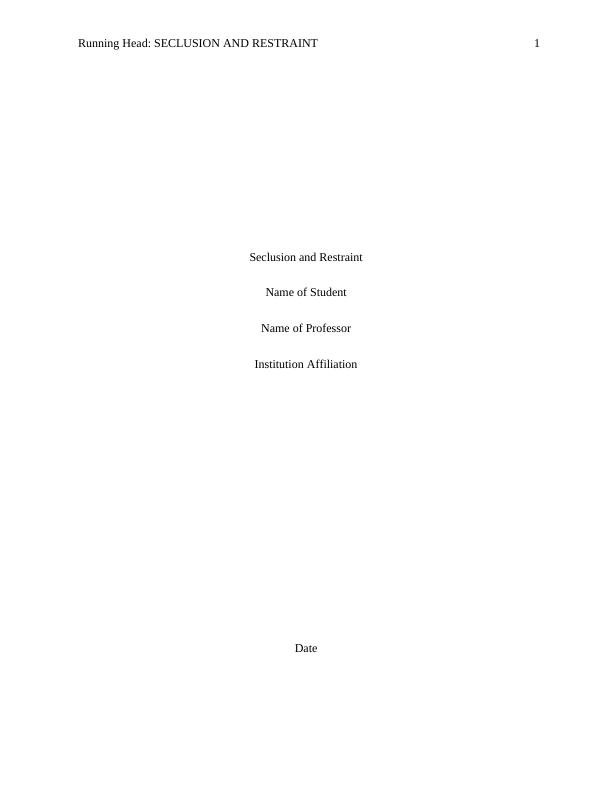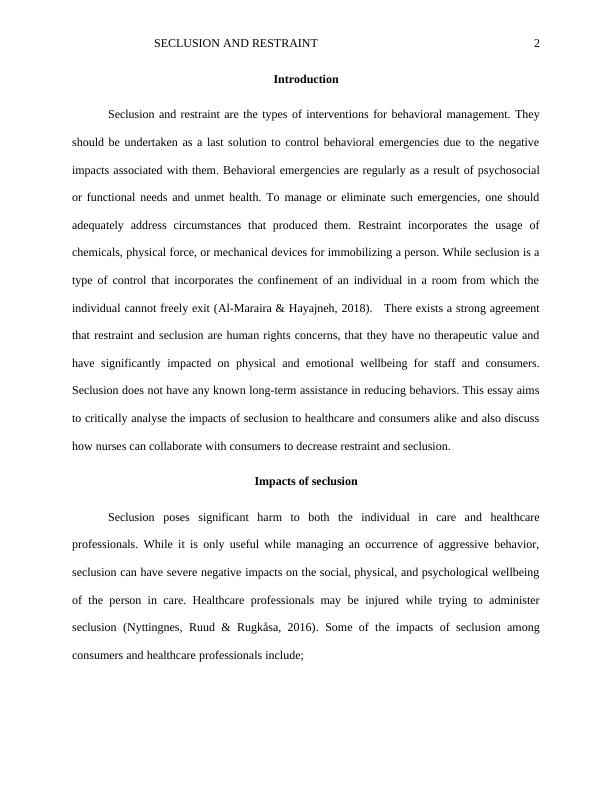Seclusion and Restraint - Behavioral Management
12 Pages3445 Words30 Views
Added on 2022-09-06
Seclusion and Restraint - Behavioral Management
Added on 2022-09-06
ShareRelated Documents
Running Head: SECLUSION AND RESTRAINT 1
Seclusion and Restraint
Name of Student
Name of Professor
Institution Affiliation
Date
Seclusion and Restraint
Name of Student
Name of Professor
Institution Affiliation
Date

SECLUSION AND RESTRAINT 2
Introduction
Seclusion and restraint are the types of interventions for behavioral management. They
should be undertaken as a last solution to control behavioral emergencies due to the negative
impacts associated with them. Behavioral emergencies are regularly as a result of psychosocial
or functional needs and unmet health. To manage or eliminate such emergencies, one should
adequately address circumstances that produced them. Restraint incorporates the usage of
chemicals, physical force, or mechanical devices for immobilizing a person. While seclusion is a
type of control that incorporates the confinement of an individual in a room from which the
individual cannot freely exit (Al-Maraira & Hayajneh, 2018). There exists a strong agreement
that restraint and seclusion are human rights concerns, that they have no therapeutic value and
have significantly impacted on physical and emotional wellbeing for staff and consumers.
Seclusion does not have any known long-term assistance in reducing behaviors. This essay aims
to critically analyse the impacts of seclusion to healthcare and consumers alike and also discuss
how nurses can collaborate with consumers to decrease restraint and seclusion.
Impacts of seclusion
Seclusion poses significant harm to both the individual in care and healthcare
professionals. While it is only useful while managing an occurrence of aggressive behavior,
seclusion can have severe negative impacts on the social, physical, and psychological wellbeing
of the person in care. Healthcare professionals may be injured while trying to administer
seclusion (Nyttingnes, Ruud & Rugkåsa, 2016). Some of the impacts of seclusion among
consumers and healthcare professionals include;
Introduction
Seclusion and restraint are the types of interventions for behavioral management. They
should be undertaken as a last solution to control behavioral emergencies due to the negative
impacts associated with them. Behavioral emergencies are regularly as a result of psychosocial
or functional needs and unmet health. To manage or eliminate such emergencies, one should
adequately address circumstances that produced them. Restraint incorporates the usage of
chemicals, physical force, or mechanical devices for immobilizing a person. While seclusion is a
type of control that incorporates the confinement of an individual in a room from which the
individual cannot freely exit (Al-Maraira & Hayajneh, 2018). There exists a strong agreement
that restraint and seclusion are human rights concerns, that they have no therapeutic value and
have significantly impacted on physical and emotional wellbeing for staff and consumers.
Seclusion does not have any known long-term assistance in reducing behaviors. This essay aims
to critically analyse the impacts of seclusion to healthcare and consumers alike and also discuss
how nurses can collaborate with consumers to decrease restraint and seclusion.
Impacts of seclusion
Seclusion poses significant harm to both the individual in care and healthcare
professionals. While it is only useful while managing an occurrence of aggressive behavior,
seclusion can have severe negative impacts on the social, physical, and psychological wellbeing
of the person in care. Healthcare professionals may be injured while trying to administer
seclusion (Nyttingnes, Ruud & Rugkåsa, 2016). Some of the impacts of seclusion among
consumers and healthcare professionals include;

SECLUSION AND RESTRAINT 3
When a person is subjected to seclusion, then he/she might not be willing to seek
treatment. This affects the psychological and physical wellbeing of the consumer. The practices
associated with seclusion are brutal and stressful. Once an individual gets out of the hospital, the
fear of being stressed again makes them unwilling to seek medical assistance again (Goulet &
Larue, 2016). A mental ward practicing seclusion ought to know that seclusion results in
insomnia, stress, pain, distrust in services offered, and nightmares. Victims also experience poor
hospitalization, constant depression, and trauma of torture flashbacks. This poses a lot of danger
in their health status and more risks to the relatives and friends around them or the entire
community. The impacts associated with the use of seclusion are intense and unfavorable, and
hence nobody will be willing to experience such circumstances again (Cusack, Cusack,
McAndrew, McKeown & Duxbury, 2018).
Seclusion also poses a significant challenge to healthcare professionals taking care of the
patients. The same way it affects the physical and psychological wellbeing of the consumers,
also the healthcare professionals are influenced. The environment for offering mental care calls
for perseverance, resources, patience, and ample space to facilitate the delivery of quality
services by the care providers in order to achieve distinct requirements of patients. The current
practice of seclusion poses a significant challenge to healthcare professionals by making the
environment unfavorable since it can result in injuries and emotional damage (Ramluggun,
Chalmers & Anjoyeb, 2018). Some healthcare professionals have not been able to realize the
dangers that seclusion poses on them. Seclusion does not only harm the patient but also creates a
platform for a horrible working environment. Furthermore, potential people who admire such
professions may be scared to undertake the profession if it is associated with causing harm to the
When a person is subjected to seclusion, then he/she might not be willing to seek
treatment. This affects the psychological and physical wellbeing of the consumer. The practices
associated with seclusion are brutal and stressful. Once an individual gets out of the hospital, the
fear of being stressed again makes them unwilling to seek medical assistance again (Goulet &
Larue, 2016). A mental ward practicing seclusion ought to know that seclusion results in
insomnia, stress, pain, distrust in services offered, and nightmares. Victims also experience poor
hospitalization, constant depression, and trauma of torture flashbacks. This poses a lot of danger
in their health status and more risks to the relatives and friends around them or the entire
community. The impacts associated with the use of seclusion are intense and unfavorable, and
hence nobody will be willing to experience such circumstances again (Cusack, Cusack,
McAndrew, McKeown & Duxbury, 2018).
Seclusion also poses a significant challenge to healthcare professionals taking care of the
patients. The same way it affects the physical and psychological wellbeing of the consumers,
also the healthcare professionals are influenced. The environment for offering mental care calls
for perseverance, resources, patience, and ample space to facilitate the delivery of quality
services by the care providers in order to achieve distinct requirements of patients. The current
practice of seclusion poses a significant challenge to healthcare professionals by making the
environment unfavorable since it can result in injuries and emotional damage (Ramluggun,
Chalmers & Anjoyeb, 2018). Some healthcare professionals have not been able to realize the
dangers that seclusion poses on them. Seclusion does not only harm the patient but also creates a
platform for a horrible working environment. Furthermore, potential people who admire such
professions may be scared to undertake the profession if it is associated with causing harm to the

SECLUSION AND RESTRAINT 4
patients instead of helping them. No one would wish to work in such an environment (Foster,
Roche, Giandinoto & Furness, 2020).
Seclusion also results in trauma and excessive control over the patients. Seclusion results
in trauma, and since the patient is isolated, chances are he/she is capable of reflecting on the past
trauma. Also, the act of using excessive force and exposure to a consumer with traumatic
patients can trigger trauma among healthcare professionals. Patients who have previously
experienced traumatic events like sexual or physical abuse assault are more vulnerable to trauma.
If previously suffered a trauma, a person is more vulnerable to experience post-traumatic stress
disorder as the re-experiencing of flashbacks, events, nightmares, intrusive, and repetitive images
from the event occur. Also, the experiences of seclusion may result in trauma. Trauma results in
patients and healthcare professionals being unable to balance between seclusion and crisis.
Seclusion also results in excessive control by the healthcare professionals since through it,
healthcare professionals are capable of gaining control over consumers and managing the
environment they are in (Peterson, 2017). The acts of controlling make it hard to develop
therapeutic communication between the healthcare professional and the patient. Therapeutic
communication is one of the essential element in the provision of care since healthcare
professionals use it to build trust and rapport. Without effective therapeutic communication, then
the quality of care provided can be low. This is because nurses and patients are not capable of
imagining, informing, expressing feelings, influencing and meeting the social expectations of the
care provided (Franke, Buesselmann, Streb & Dudeck, 2019).
Additionally, seclusion results in emotional instability. Emotions that are more likely to
be experienced by consumers during seclusion include; fear of the confined space,
disempowerment, ongoing feelings of vulnerability, and anger linked with physical practices that
patients instead of helping them. No one would wish to work in such an environment (Foster,
Roche, Giandinoto & Furness, 2020).
Seclusion also results in trauma and excessive control over the patients. Seclusion results
in trauma, and since the patient is isolated, chances are he/she is capable of reflecting on the past
trauma. Also, the act of using excessive force and exposure to a consumer with traumatic
patients can trigger trauma among healthcare professionals. Patients who have previously
experienced traumatic events like sexual or physical abuse assault are more vulnerable to trauma.
If previously suffered a trauma, a person is more vulnerable to experience post-traumatic stress
disorder as the re-experiencing of flashbacks, events, nightmares, intrusive, and repetitive images
from the event occur. Also, the experiences of seclusion may result in trauma. Trauma results in
patients and healthcare professionals being unable to balance between seclusion and crisis.
Seclusion also results in excessive control by the healthcare professionals since through it,
healthcare professionals are capable of gaining control over consumers and managing the
environment they are in (Peterson, 2017). The acts of controlling make it hard to develop
therapeutic communication between the healthcare professional and the patient. Therapeutic
communication is one of the essential element in the provision of care since healthcare
professionals use it to build trust and rapport. Without effective therapeutic communication, then
the quality of care provided can be low. This is because nurses and patients are not capable of
imagining, informing, expressing feelings, influencing and meeting the social expectations of the
care provided (Franke, Buesselmann, Streb & Dudeck, 2019).
Additionally, seclusion results in emotional instability. Emotions that are more likely to
be experienced by consumers during seclusion include; fear of the confined space,
disempowerment, ongoing feelings of vulnerability, and anger linked with physical practices that

End of preview
Want to access all the pages? Upload your documents or become a member.
Related Documents
Journal of Korean Academy of Psychiatriclg...
|10
|2698
|14
Safety and Physical Punishmentlg...
|12
|3467
|22
Impact of Seclusion on Patients and Healthcare Professionalslg...
|12
|3416
|39
Essay | Effects of Seclusion on Healthcare Personnellg...
|12
|3578
|21
Use of Seclusion and Restraint - Nursinglg...
|12
|3231
|21
Essay on Mental Health 2022lg...
|12
|3204
|13
